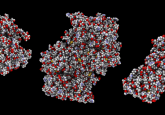Large molecule quantification: sensitivity and selectivity head-to-head comparison of triple quadrupole with Q-TOF

Background: Bioanalysts are continuously looking for innovative ideas or instruments to increase the sensitivity and selectivity of their assays. Research for better mass spectrometers is becoming crucial with the emerging trend of large-molecule quantification. This study lists the different advantages of high-resolution MS (HRMS) over standard triple quadrupole instruments and proposes basic guidelines on how to use HRMS for large-molecule quantification in a regulated environment. Results: A direct comparison between HRMS and triple quadrupole instruments for the quantification of six different model peptides (desmopressin, calcitonin, enfuvirtide, exenatide, glucagon and somatostatin) was completed. The HRMS instrument, when used specifically for targeted quantification (‘quant/quant’), showed equivalent or better sensitivity for all compounds tested. Conclusion: This paper demonstrates that the use of a HRMS instrument in a regulated environment is a viable technique for quantification of large molecules. The latter was able to allow flexibility and selectivity to adapt the specificity of each assay with sensitivity comparable to the triple quadrupole instrument.
Over the last 2 decades, mass spectrometers have played a key role in the evolution of bioanalysis by increasing the selectivity, sensitivity and the overall quality of bioanalytical assays. In fact, these systems are in perpetual evolution in order to match new requirements established by the industry. Among the spectrometric detectors family, high-resolution MS (HRMS) have started to revolutionize the quantitative bioanalysis industry by offering a new paradigm of sensitivity and selectivity. The advantages of the HRMS instrument for quantification are well documented and manufacturers are now proposing high-resolution detectors as an alternative to regular triple quadrupole for quantification. Previously associated with metabolite identification and other qualitative purposes, these detectors are now reaching the sensitivity and linearity offered by common triple quadrupole instruments, which are still considered as the gold standard for quantitative analyses.
Click here for the full article.





